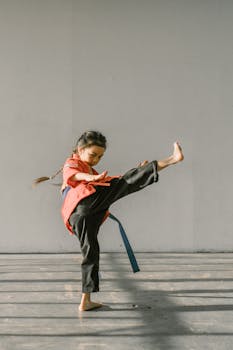
Image by RDNE Stock project on Pixabay
"Unraveling the Meaning Behind Karate Uniforms" "The Armor of Tradition: Unlocking the
Karate Uniforms as Symbolic Representations: Exploring Cultural Significance and IconographyThe Evolution of Karate Uniforms
Karate uniforms have undergone significant transformations over the years, reflecting the cultural, social, and historical contexts in which they were designed. These ensembles not only serve a practical purpose but also hold symbolic meanings that transcend their functional aspects. In this article, we will delve into the world of karate uniforms as symbolic representations, exploring their cultural significance, iconography, benefits, and advantages.A Brief History of Karate Uniforms
The history of karate uniforms dates back to ancient Japan, where they were worn by martial artists practicing various forms of combat, including archery and sword fighting. In the early 20th century, karate emerged as a distinct martial art, and its uniform design evolved accordingly. The first karate uniforms consisted of simple cotton or linen garments with minimal embellishments.Karate Uniforms: A Symbol of Discipline and Self-Improvement
Karate uniforms have long been associated with discipline, self-improvement, and personal growth. They represent a commitment to the values of karate, such as respect, perseverance, and self-control. The uniform's design and color scheme are often chosen to reflect these values, with black representing humility and simplicity, while white symbolizes purity and cleanliness.The Role of Uniforms in Karate Traditions
Karate uniforms play a significant role in various martial arts traditions, including karate, judo, and taekwondo. In each tradition, the uniform is an integral part of the practitioner's attire, serving as a visual representation of their affiliation with the particular martial art. The uniform's design and color scheme may also be used to signify different levels of proficiency or experience.Karate Uniforms: A Reflection of Cultural Significance
Karate uniforms are not only symbolic representations but also reflect cultural significance in various parts of the world. For instance, in Japan, karate uniforms have been an integral part of traditional martial arts for centuries, with each region having its unique design and color scheme. Similarly, in Korea, Korean martial arts such as taekwondo and judo are often associated with specific uniforms that reflect their cultural heritage.The Iconography of Karate Uniforms
Karate uniform iconography is a key aspect of their symbolic representation. The design of the uniform, including its shape, color scheme, and embellishments, conveys meaning and significance to the practitioner. For example, the use of traditional Japanese designs, such as the yuketsu (white ribbon) or the hizashi (red stripe), is a common feature in many martial arts uniforms.Benefits and Advantages
Karate uniforms offer several benefits and advantages that make them an essential part of karate training. These include:Practicality
: Karate uniforms are designed to be functional, providing protection from injury while allowing for freedom of movement.Symbolism
: As mentioned earlier, karate uniforms serve as a visual representation of the practitioner's values and affiliations with the particular martial art.Teamwork
: Uniforms often feature team logos or colors, promoting unity and cooperation among practitioners.Personal Expression
: Karate uniforms provide an opportunity for personal expression, allowing practitioners to showcase their individuality through unique designs or color schemes.
Case Studies: Real-World Applications of Karate Uniforms
Karate uniforms have been used in various real-world applications, including:Martial Arts Competitions
: Uniforms are often worn by competitors during martial arts tournaments, symbolizing their affiliation with the particular martial art.Schools and Academies
: Many schools and academies use karate uniforms as a way to promote unity and cooperation among students.Businesses and Organizations
: Companies and organizations may adopt karate uniforms as a unique marketing tool or to convey their values.
Conclusion: Karate Uniforms as Symbolic Representations
Karate uniforms are more than just practical attire; they serve as symbolic representations of the practitioner's values, affiliations, and cultural heritage. As we explore the world of karate uniforms as symbolic representations, it becomes clear that these ensembles hold significant meaning beyond their functional aspects.Practical Tips and Recommendations
If you're interested in incorporating karate uniforms into your life or training, here are some practical tips and recommendations:Choose a high-quality uniform
: A well-made uniform is essential for optimal comfort and performance.Experiment with different designs
: Try out various designs and color schemes to find the one that suits you best.Pay attention to materials
: Choose fabrics that are breathable, durable, and suitable for your training needs.